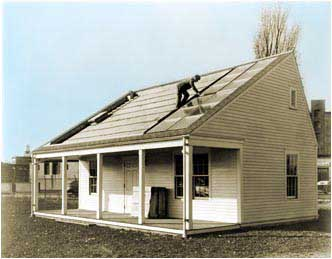A Machine for Climate:
The House Beautiful/AIA Climate Control Project
1949-1952
3.1 | Context
Solar 1: The MIT Solar House, 1938
The first MIT solar house was built in 1938. The project marked the beginning of what would become two decades of research, resulting in over five homes. Solar 1 was an active solar house. The use of heat for passive solar heating had been in use since the 1880s when it first was used for heating hot water. At the beginning of the 20th century, planning with solar principles in mind, particularly the human right to solar access, would drive the planning of housing for industrial labor. During the late 1930s and early 1940s, professionals such as Keck & Keck Architects would employ passive solar design principles in their designs for middle and upper class homes. The effectiveness of passive solar design in reducing heating bills was not clear however, as the aesthetic of a passive solar home was easy for developers and other architects to copy without actually planning for a particular result. Shortly after Keck & Keck Architects' success, developers who chose to use passive solar principles to drive their home designs sprung up, but these endeavours were short-lived.
The project at MIT was enabled by a grant from Godfrey Lowell Cabot, a wealthy Boston resident. Director of Research was Professor Hoyt Hottel, a chemical engineering professor. The research goal for the project was to conduct a rigorous scientific study of the technical and economic feasibility of using solar energy exclusively to generate heat. The other major difference between the MIT project and those completed in the past was that MIT's home was active, rather than passive solar. The heat which was collected was used to heat the home year-round which meant that the heat needed to be stored. In the 1950s, many solar projects were designed and built. These projects were often homes and office buildings as the intention was to demonstrate that comfort, convenience, and aesthetics did not need to be sacrificed when designing with climate.
One of the important contradictions discovered by the MIT projects during early uses of solar energy was that predicted and actual living conditions often differed. From this we can conclude that designing with climate is not a precise science, and one that is very difficult to predict with extreme accuracy. The MIT solar project eventually demonstrated that heating derived from solar energy in a climate such as the one found in Boston was actually possible, but at the time, not economically feasible.
In 1962, the project was terminated because of cost.

Image from Wikipedia.com.
Additional articles on the MIT solar houses can be found at the MIT Libraries.